The name of this Wetherspoon free house recalls the ideal pub described in detail by George Orwell. The famous writer called his fictitious pub ‘Moon Under Water’. In Victorian times, 44 High Street was the home of the Sedgwicks – leading local lawyers. In 1917, the premises became the Empress Winter Gardens and then the Bohemian Cinema. For many years afterwards, it was used as a furniture store and various shops, until this pub opened in 1995.
Text about The Moon Under Water.
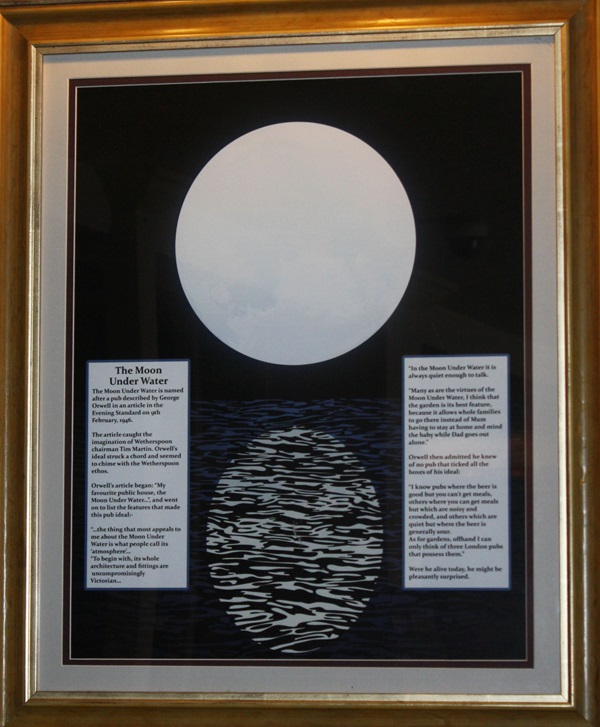
The text reads: The Moon Under Water is named after a pub described by George Orwell in an article in the Evening Standard on 9 February, 1946.
The article caught the imagination of Wetherspoon chairman Tim Martin. Orwell’s ideal struck a chord and seemed to chime with the Wetherspoon ethos.
Orwell’s article began: “My favourite public house, the Moon Under Water…”, and went on the list features that made this pub ideal:
“…the thing that most appeals to me about the Moon Under Water is what people call its ‘atmosphere’”…
“To begin with, its whole architecture and fittings are uncompromisingly Victorian”…
“In the Moon Under Water it is always quiet enough to talk”.
“Many as are the virtues of the Moon Under Water, I think that the garden is its best feature, because it allows whole families to go there instead of Mum having to stay at home and mind the baby while Dad goes out alone”.
Orwell then admitted he knew of no pub that ticked all the boxes of his ideal:
“I know pubs where the beer is good but you can’t get meals, others where you can get meals but which are noisy and crowded, and others which are quiet but where the beer is generally sour.
As for gardens, offhand I can only think of three London pubs that possess them”.
Were he alive today, he might be pleasantly surprised.
Prints and text about Grinling Gibbons.
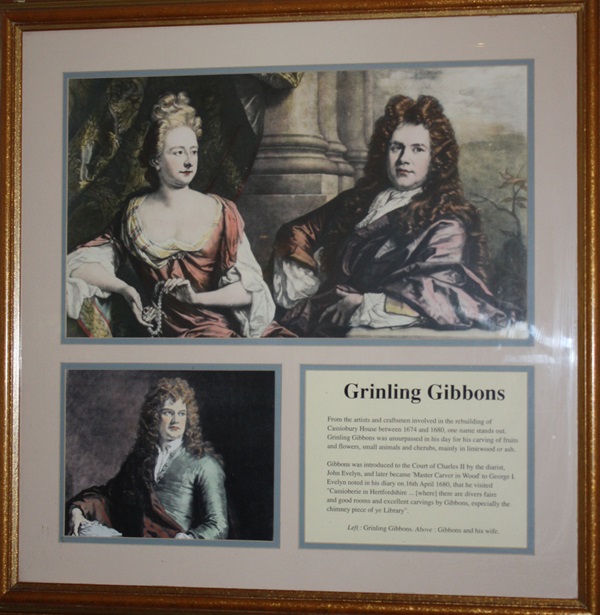
The text reads: From the artists and craftsmen involved in the rebuilding of Cassiobury House between 1674 and 1680, one name stands out. Grinling Gibbons was unsurpassed in his day for his carving of fruits and flowers, small animals and cherubs, mainly in limewood or ash.
Gibbons was introduced to the Court of Charles II by the diarist, John Evelyn, and later became ‘Master Carver in Wood’ to George I. Evelyn noted in his diary on 16 April 1680, that he visited “Cassioberie in Hertfordshire... [where] there are divers faire and good rooms and excellent carvings by Gibbons, especially the chimney piece of ye Library”.
Left: Grinling Gibbons
Above: Gibbons and his wife.
Illustrations and text about the Morison family.
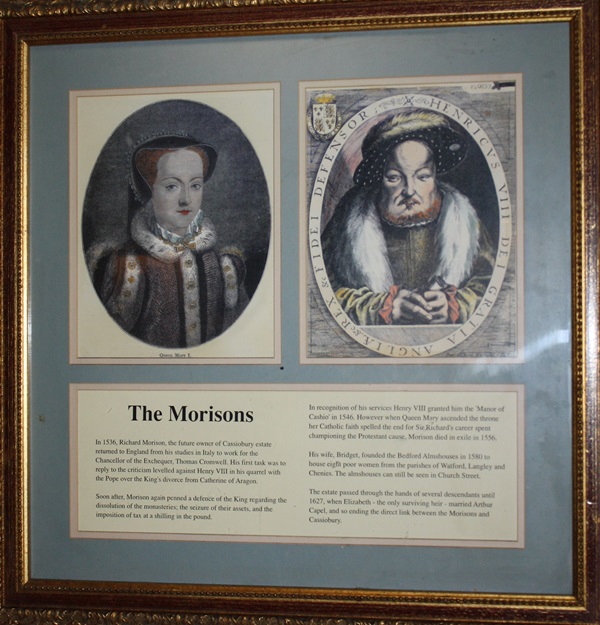
The text reads: In 1536, Richard Morison, the future owner of Cassiobury estate returned to England from his studies in Italy to work for the Chancellor of the Exchequer, Thomas Cromwell. His first task was to reply to the criticism levelled against Henry VIII in his quarrel with the Pope over the King’s divorce from Catherine of Aragon.
Soon after, Morison again penned a defence of the King regarding the dissolution of the monasteries; the seizure of their assets, and the imposition of tax at a shilling in the pound.
In recognition of his services Henry VIII granted him the Manor of Cashio in 1546. However when Queen Mary ascended the throne her Catholic faith spelled the end for Sir Richard’s career spent championing the Protestant cause. Morison died in exile in 1556.
His wife, Bridget, founded the Bedford Almshouses in 1580 to house eight poor women from the parishes of Watford, Langley and Chenies. The almshouses can still be seen in Church Street.
The estate passed though the hands of several descendants until 1627, when Elizabeth – the only surviving heir – married Arthur Capel, and so ending the direct link between the Morisons and Cassiobury.
A print and text about William von Herkomer.
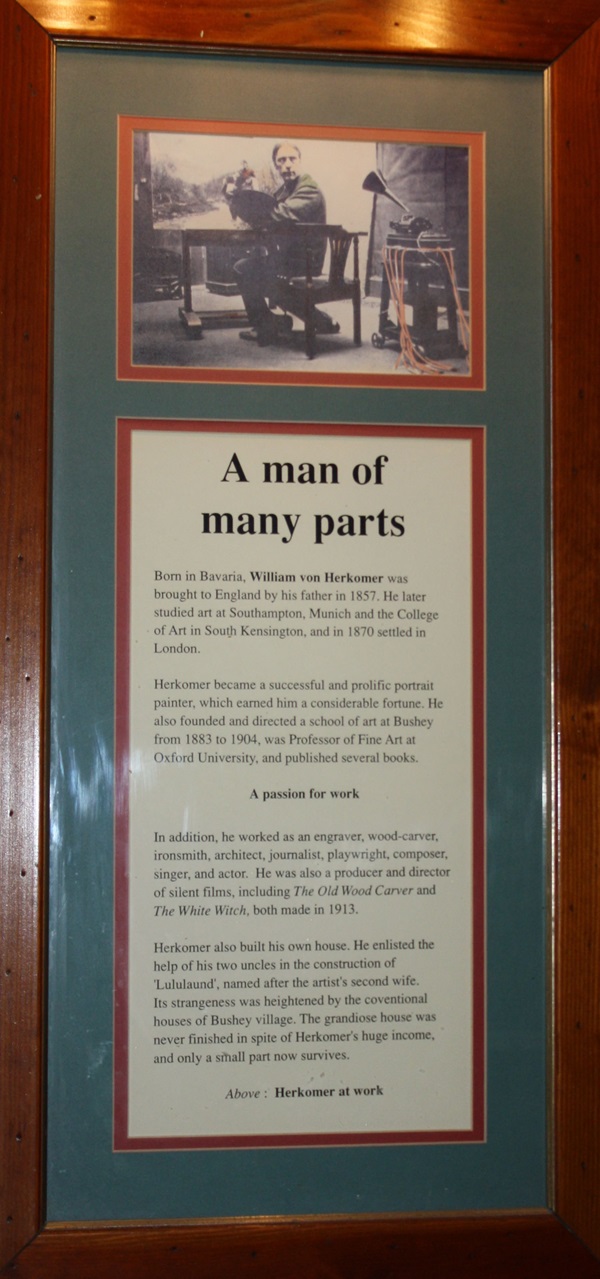
The text reads: Born in Bavaria, William von Herkomer was brought to England by his father in 1857. He later studied art at Southampton, Munich and the College of Art in South Kensington, and in 1870 settled in London.
Herkomer became a successful and prolific portrait painter, which earned him a considerable fortune. He also founded and directed a school of art at Bushey from 1883 to 1904, was Professor of Fine Art at Oxford University, and published several books.
In addition, he worked as an engraver, wood-carver, ironsmith, architect, journalist, playwright, composer, singer, and actor. He was also a producer and director of silent films, including The Old Wood Carver and The White Witch, both made in 1913.
Herkomer also built his own house. He enlisted the help of his two uncles in the construction of Lululand, named after the artist’s second wife. Its strangeness was heightened by the conventional houses of Bushey village. The grandiose house was never finished in spite of Herkomer’s huge income, and only a small part now survives.
Above: Herkomer at work.
Illustrations and text about printing.
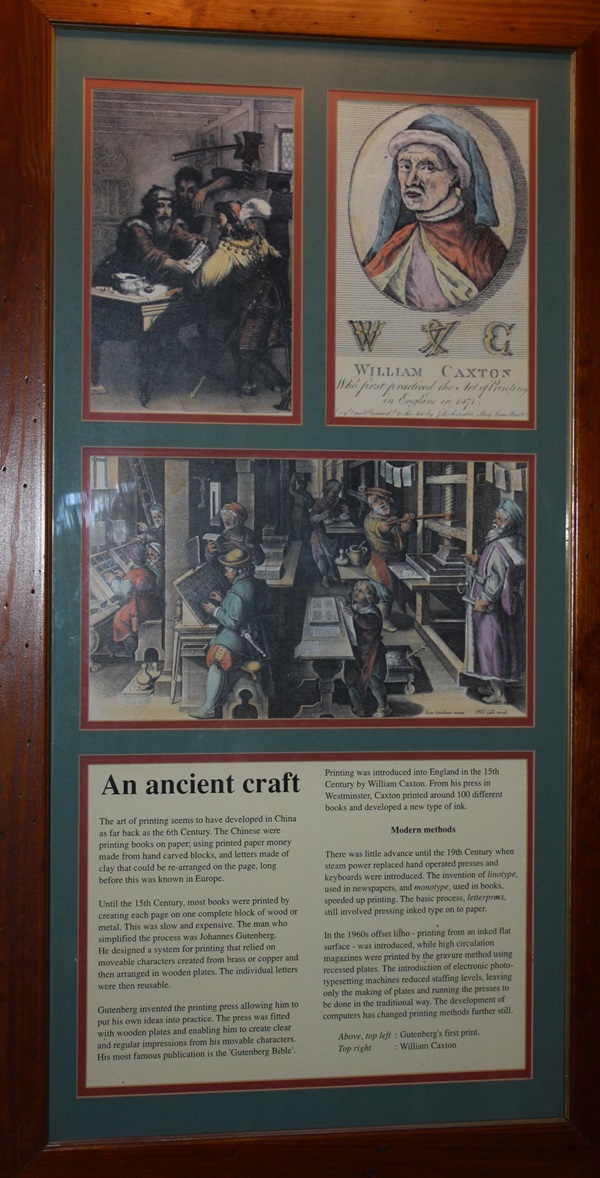
The text reads: The art of printing seems to have developed in China as far back as the 6th century. The Chinese were printing books on paper, using printed paper money made from hand carved blocks, and letters made of clay that could be re-arranged on the page, long before this was known in Europe.
Until the 15th century, most books were printed by creating each page on one complete block of wood or metal. This was slow and expensive. The man who simplified the process was Johannes Gutenberg.
He designed characters created from brass or copper and then arranged in wooden plates. The individual letters were then reusable.
Gutenberg invented the printing press allowing him to put his own ideas in to practice. The press was fitted with wooden plates and enabling him to create clear and regular impressions from his movable characters. His most famous publication is the Gutenberg Bible.
Printing was introduced into England in the 15th century by William Caxton. From his press in Westminster, Caxton printed around 100 different books and developed a new type of ink.
There was little advance until the 19th century when steam power replaced hand operated presses and keyboards were replaced hand operated presses and keyboards were introduced. The invention of linotype, used in newspapers, and monotype, used in books, speeded up printing. The basic process, letterpress still involved pressing inked type on to paper.
In the 1960s offset litho – printing from an inked flat surface – was introduced, while high circulation magazines were printed by the gravure method using recessed plates. The introduction of electronic phototypesetting machines reduced staffing levels, leaving only the making of plates and running the press to be done in the traditional way. The development of computers has changed printing methods further still.
Above, top left: Gutenberg’s first print
Top right: William Caxton.
Illustrations and text about printing in Watford.

The text reads: The print trade in Watford developed from humble beginnings into a major industry, and is still a source of employment in the town. In early 19th century John Peacock was the only printer in Watford.
His business was taken over by his son Samuel, who, in 1863, founded the Watford Observer. This began the family’s long association with the paper. The first edition of the Observer rolled off the Columbian press which is now on display in Watford Museum.
By the end of the 19th century there were a number of small printing companies in and around Watford offering engraving and colour printing. During the 1st World War local films printed paper money for the Bank of England.
During the 1930s Watford earned a reputation as the most important town in England for printing. This was confirmed when Odhams – a giant printing company – moved here in 1935.
In the inter-war years the town also became the centre for the production of ‘periodicals’. By 1939 the Sun Engraving Company had a work force of over 2,000 – organised in shifts – producing top selling magazines such as Women’s Own, Country Life, Radio Times and Vogue. The circulation of the weekly publications it printed exceeded six million, and its monthly titles had more than two million readers.
Production levels fell as a result of the paper shortage during the 2nd World War, but the Sun Company was able to get contracts for secret government work. While this work was printed the entrances and exits to the printing plant were patrolled by the Home Guard.
Since the war the print trade in Watford has declined. Town still has a printing industry, but the introduction of new technology, closures and mergers have all taken their toll.
Illustrations and text about Watford’s past.
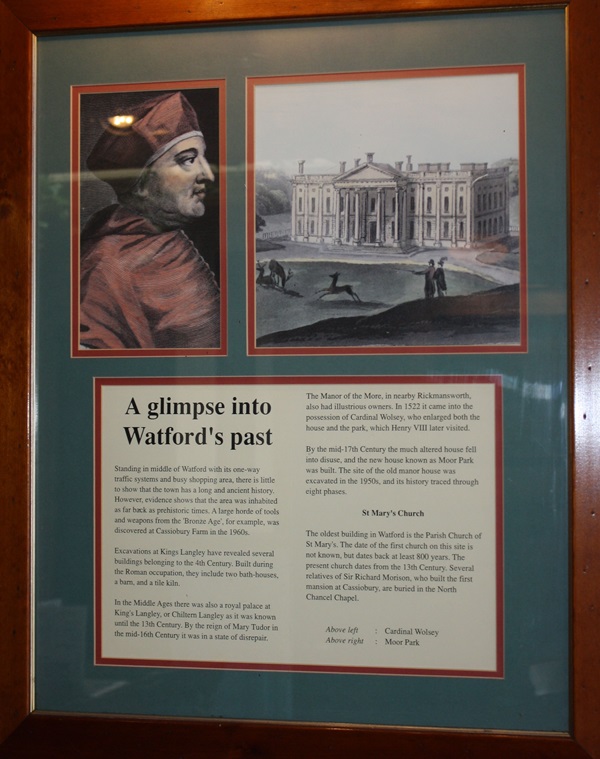
The text reads: Standing in the middle of Watford with its one-way traffic systems and busy shopping area, there is little to show that the town has a long and ancient history. However, evidence shows that the area was inhabited as far back as prehistoric times. A large horde of tools and weapons from the Bronze Age, for example, was discovered at Cassiobury Farm in the 1960s.
Excavations at Kings Langley have revealed several buildings belonging to the 4th century. Built during the Roman occupation, they include two bath-houses, a barn, and a title kiln.
In the Middle Ages there was also a royal palace at King’s Langley, or Chiltern Langley as it was known until the 13th century. By the reign of Mary Tudor in the mid-16th century it was in a state of disrepair.
The Manor of the More, in nearby Rickmansworth, also had illustrious owners. In 1522 it came into the possession of Cardinal Wolsey, who enlarged both the house and park, which Henry VIII later visited.
By the mid-17th century the much altered house fell into disuse, and the new house known as Moor Park was built. The site of the old manor house was excavated in the 1950s, and its history traced though eight phases.
The oldest building in Watford is the Parish Church of St Mary’s. The date of the first church on this site is not known, but dates back at least 800 years. The present church dates from the 13th century. Several relatives of Sir Richard Morison, who built the first mansion at Cassiobury, are buried in the North Chancel Chapel.
Above left: Cardinal Wolsey
Above right: Moor Park.
Photographs and text about Nick Leeson.
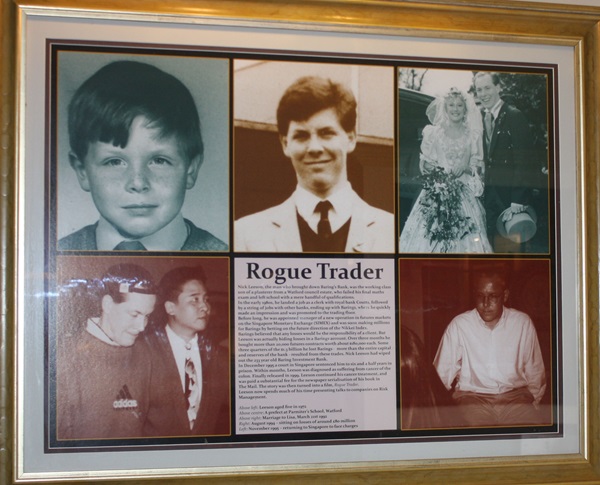
The text reads: Nick Leeson, the man who brought down Baring’s Bank, was the working class son of a plasterer from a Watford council estate, who failed his final maths exam and left school with a mere handful of qualifications.
In the early 1980s, he landed a job as a clerk with royal bank Coutts, followed by a string of jobs with other banks, ending up with Barings, where he quickly made an impression and was promoted to the trading floor.
Before long, he was appointed manager of a new operation in future markets on the Singapore Monetary Exchange (SIMEX) and was soon making millions for Baring by betting on the future directions of the Nikkei Index.
Baring believed that any losses would be the responsibility of a client. But Leeson was actually hiding losses in a Barings account. Over three months he bought more than 20,000 future contracts worth about $180,000 each. Some three quarters of the $1.3 billion he lost Barings- more than the entire capital and reserves of the bank – resulted from these trades. Nick Leeson had wiped out the 233 year old Baring Investment Bank.
In December 1995 a court in Singapore sentenced him to six and a half years in prison. Within months, Leeson was diagnosed as suffering from cancer of the colon. Finally released in 1999, Leeson continued his cancer treatments, and was paid a substantial fee for the newspaper serialisation fee for then turned into a film, Rogue Trader.
Leeson now spends much of his time presenting talks to companies on Risk Management.
Above left: Leeson aged five in 1972
Above centre: A prefect at Parmiter’s School, Watford
Above right: Marriage to Lisa, March 21 1992
Right: August 1994 – sitting on losses of around £80 million
Left: November 1995 – returning to Singapore to face charges.
An illustration and text about Sir Edwin Landseer.
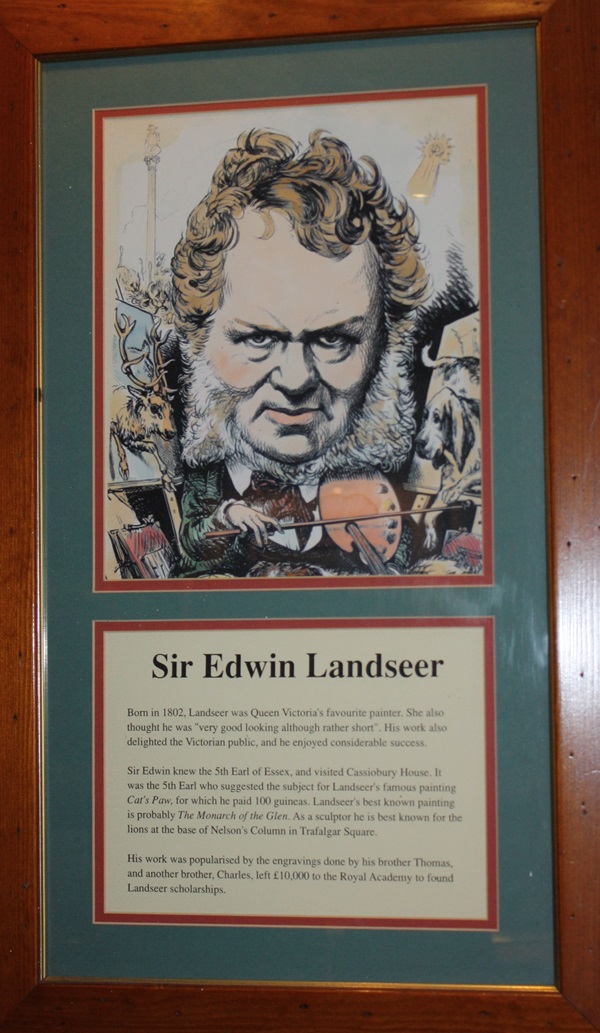
The text reads: Born in 1802, Landseer was Queen Victoria’s favourite painter. She also thought he was “very good looking although rather short”. His work also delighted the Victorian public, and he enjoyed considerable success.
Sir Edwin knew the 5th Earl of Essex, and visited Cassiobury House. It was the 5th Earl who suggested the subject for Landseer’s famous painting Cat’s Paw, for which he paid 100 guineas. Landseer’s best known painting is probably The Monarch of the Glen. As a sculptor he is best known for the lions at the base of Nelson’s Column in Trafalgar Square.
His work was popularised by engravings done by his brother Thomas, and another brother, Charles, left £10,000 to the Royal Academy to found Landseer scholarships.
Photographs and text about Vinnie Jones.
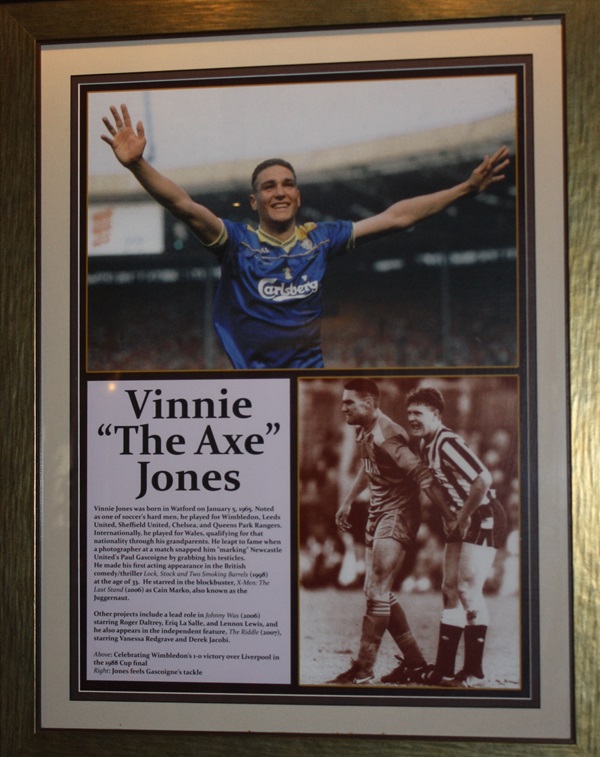
The text reads: Vinnie Jones was born in Watford on January 5, 1965. Noted as one of soccer’s hard men, he played for Wimbledon, Leeds United, Sheffield United, Chelsea, and Queens Park Rangers. Internationally, he played for Wales, qualifying for that nationality though his grandparents. He lept to fame when a photographer at a match snapped him marking Newcastle United’s Paul Gascoigne by grabbing his testicles. He made his first acting appearances in the British comedy/thriller Lock, Stock and Two Smoking Barrels (1998) at the age of 33. He starred in the blockbuster, X-Men: The Last Stand (2006) as Cain Marko, also known as the Juggernaut.
Other projects include a lead role in Johnny Was (2006) starring Roger Daltrey, Eriq La Salle, and Lennox Lewis, and he also appears in the independent feature, The Riddle (2007), starring Vanessa Redgrave and Derek Jacobi.
Above: Celebrating Wimbledon’s 1-0 victory over Liverpool in the 1988 cup final
Right: Jones feels Gascoigne’s tackle.
An illustration and text about Watford and the Civil War.
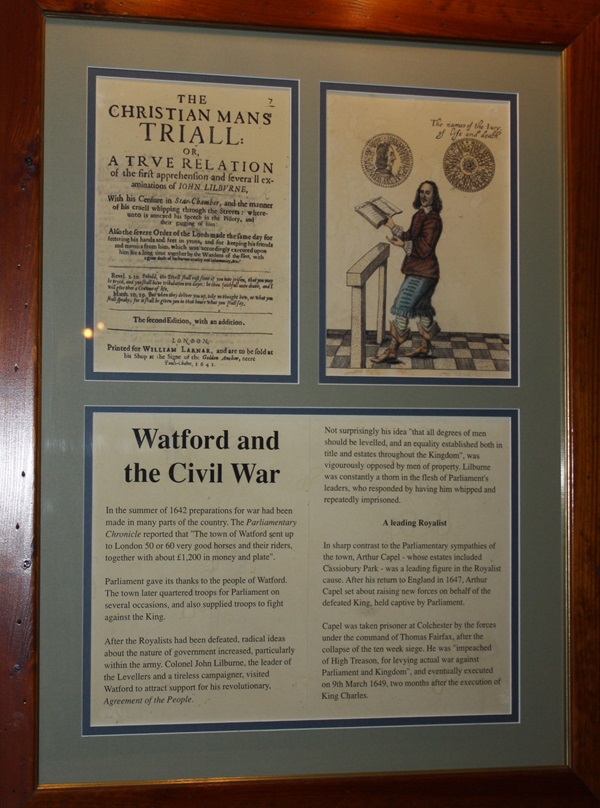
The text reads: In the summer of 1642 preparations for was had been made in many parts of the country. The Parliamentary Chronicle reported that “The town of Watford sent up to London 50 or 60 very good horses and their riders, together with about £1,200 in money and plate”.
Parliament gave its thanks to the people of Watford. The town later quartered troops for Parliament on several occasions, and also supplied troops to fight against the King.
After the Royalists had been defeated, radical ideas about the nature of government increased, particularly within the army. Colonel John Lilburne, the leader of the Levellers and a tireless campaigner, visited Watford to attract support for his revolutionary, Agreement of the People.
Not surprisingly his idea “that all degrees of men should be levelled, and an equality established both in title and estates throughout the Kingdom”, was vigorously opposed by men of property. Lilburne was constantly a thorn in the flesh of Parliament’s leaders, who responded by having him whipped and repeatedly imprisoned.
In sharp contrast to the Parliamentary sympathies of the town, Arthur Capel – whose estates included Cassiobury Park – was a leading figure in the Royalist cause. After his return to England in 1647, Arthur Capel set about raising new forces on behalf of the defeated King, held captive by Parliament.
Capel was taken prisoner at Colchester by the forces under the command of Thomas Fairfax, after the collapse of the ten week siege. He was “impeached of High Treason, for levying actual war against Parliament and Kingdom”, and eventually executed on 9 March 1649, two months after the execution of King Charles.
Text about Sir Jacob Epstein.
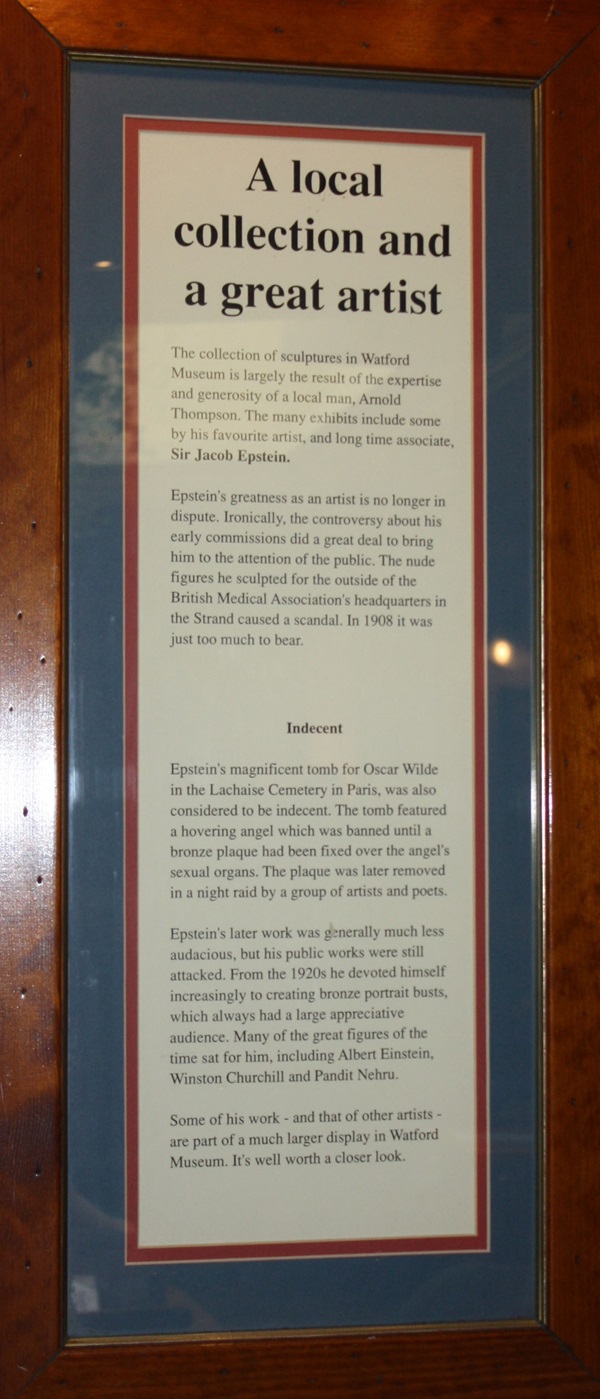
The text reads: The collection of sculptures in Watford Museum is largely the result of the expertise and generosity of a local man, Arnold Thompson. The many exhibits include some by his favourite artist, and long time associate, Sir Jacob Epstein.
Epstein’s greatness as an artist is no longer in dispute. Ironically, the controversy about his early commissions did a great deal to bring him to the attention of the public. The nude figures he sculpted for the outside of the British Medical Association’s headquarters in the Strand caused a scandal. In 1908 it was just too much to bear.
Epstein’s magnificent tomb for Oscar Wilde in the Lachaise Cemetery in Paris was also considered to be indecent. The tomb featured a hovering angel which was banned until a bronze plaque had been fixed over the angel’s sexual organs. The plaque was later removed in a night raid by a group of artists and poets.
Epstein’s later work was generally much less audacious, but his public works were still attacked. From the 1920s he devoted himself increasingly to creating bronze portrait busts, which always had a large appreciative audience. Many of the great figures of the time sat for him including Albert Einstein, Winston Churchill and Pandit Nehru.
Some of his work – and that of other artists are part of a much larger display in Watford Museum. It’s well worth a closer look.
An illustration and text about buildings in Watford.
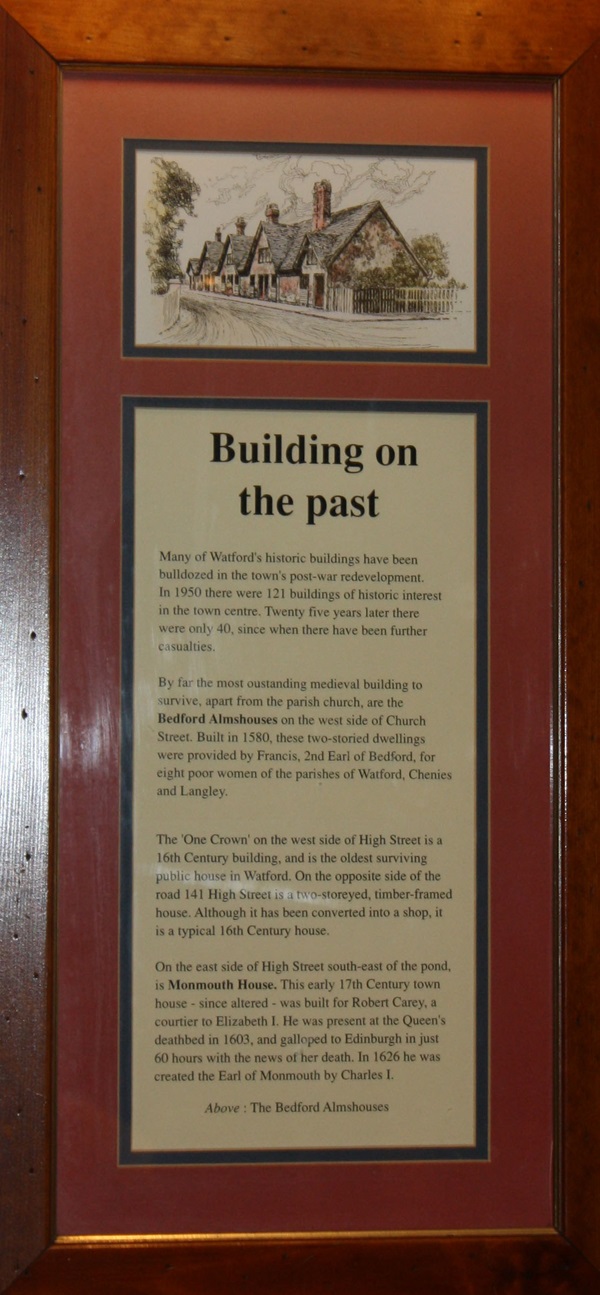
The text reads: Many of Watford’s historic buildings have been bulldozed in the town’s post-war redevelopment. In 1950 there were 121 buildings of historic interest in the town centre. Twenty five years later there were only 40, since then there have been further casualties.
By far the most outstanding medieval building to survive, apart from the parish church, are the Bedford Almshouses on the west side of Church Street. Built in 1580, these two storied dwellings were provided by Francis, 2nd Earl of Bedford, for eight poor women of the parishes of Watford, Chenies and Langley.
The ‘One Crown’ on the west side of High Street is a 16th century building, and is the oldest surviving public house in Watford. On the opposite side of the road 141 High Street is a two storeyed, timber-farmed house. Although it has been converted into a shop, it is a typical 16th century house.
On the east side of High Street south-east of the pond, is Monmouth House. This early 17th century town house – since altered – was built for Robert Carey, a courtier to Elizabeth I. He was present at the Queen’s deathbed in 1603, and galloped to Edinburgh in just 60 hours with the news of her death. In 1626 he was created the Earl of Monmouth by Charles I.
Above: The Bedford Almshouses.
Newspaper extracts, referring to the railway coming to Watford.

Prints of the Watford pond, c1900.
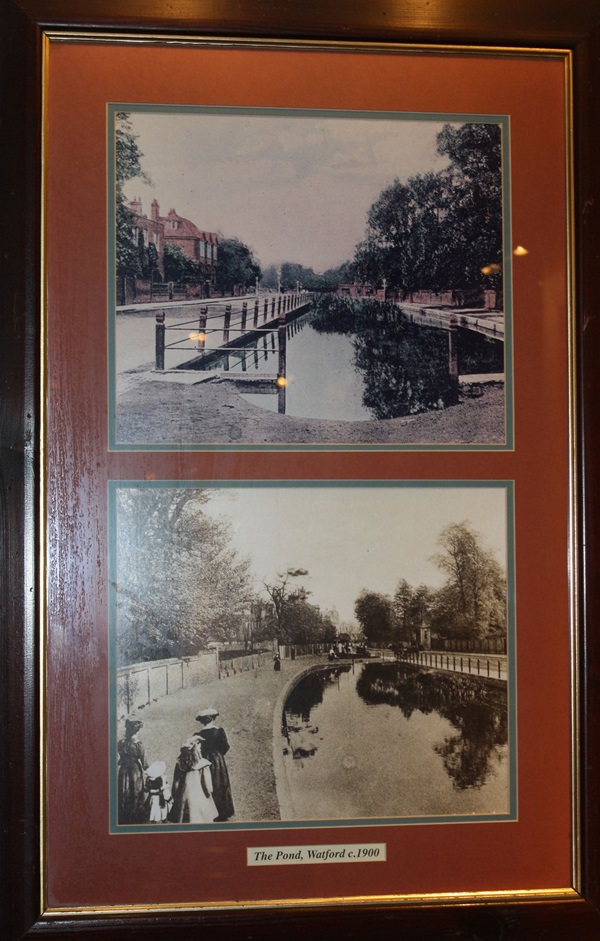
Photographs of Watford Metropolitan Station, c1920.
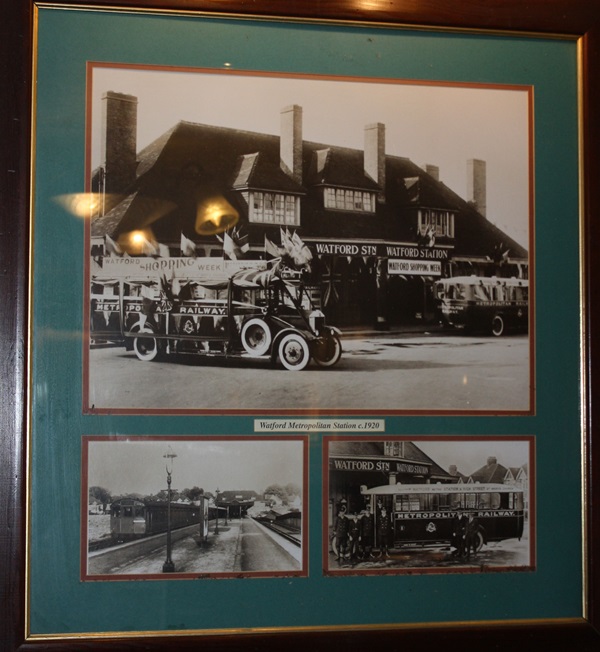
A photograph of High Street, Watford, c1921.
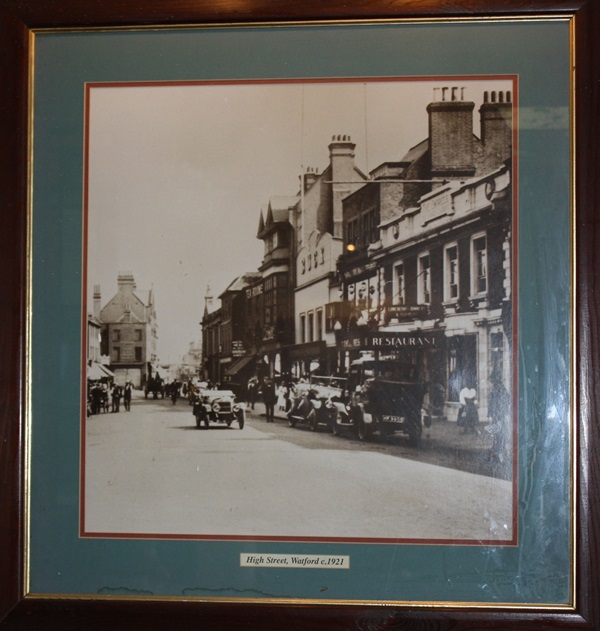
A print of High Street, Watford, c1905.
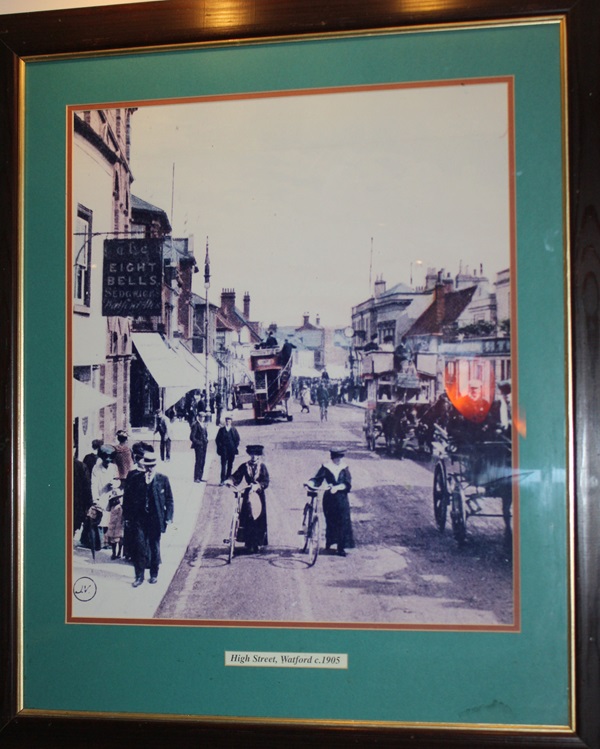
An illustration of Watford Tunnel, c1837.
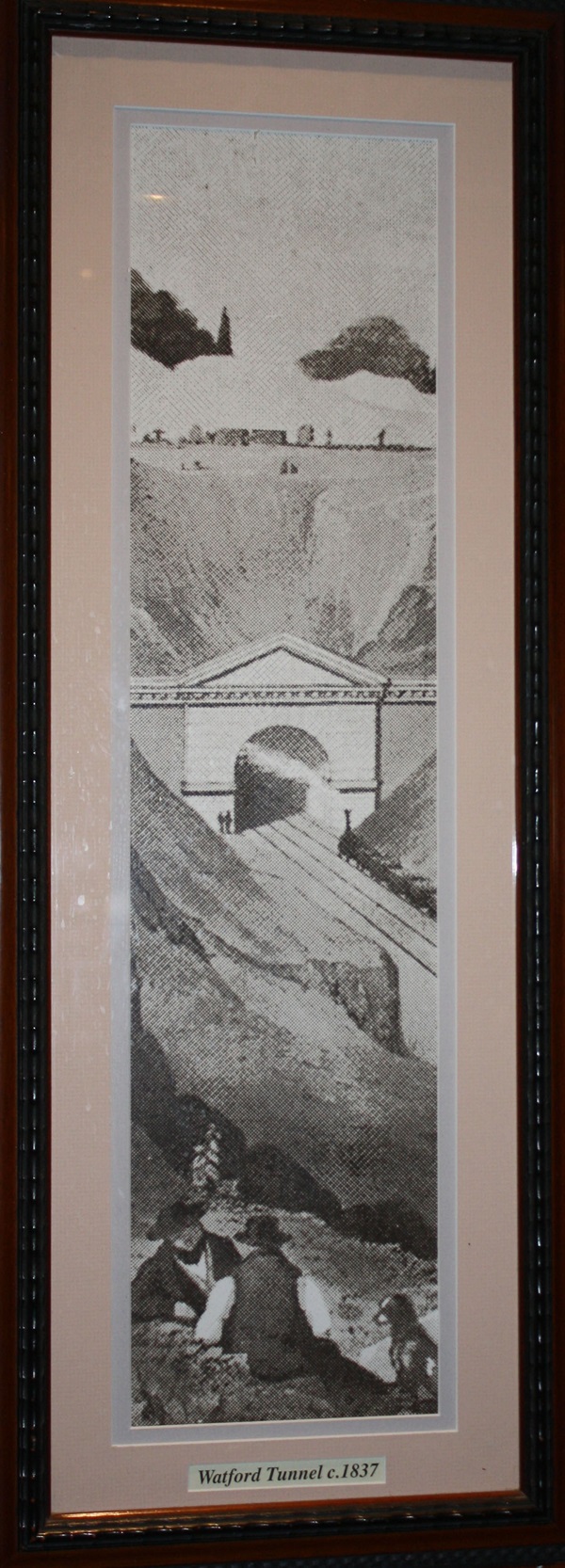
Prints of Watford.
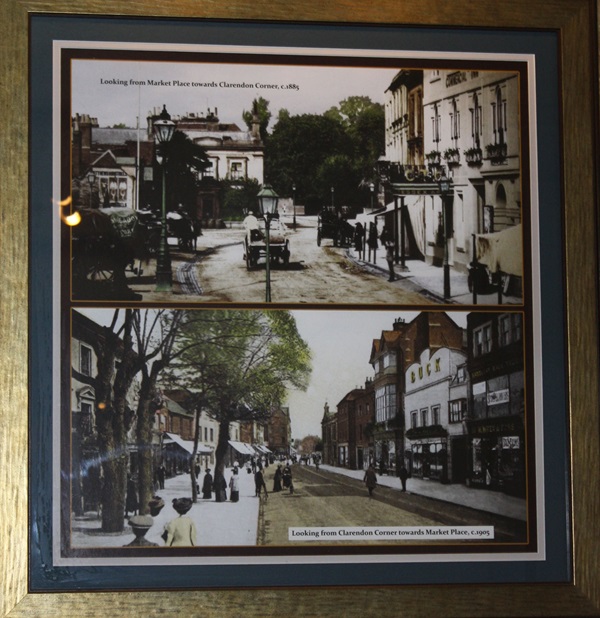
Top: Looking from Market Place towards Clarendon Corner, c1885
Below: Looking from Clarendon Corner towards Market Place, c1905.
Photographs of Watford.
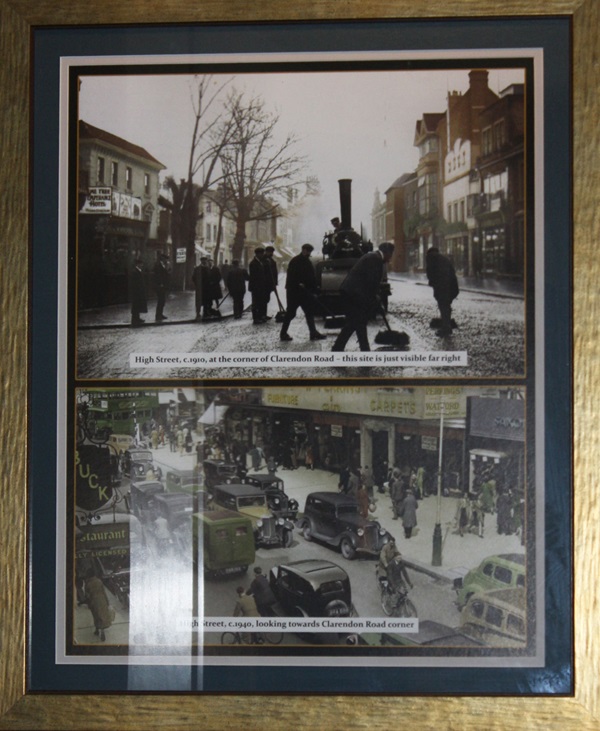
Top: High Street, c1910, at the corner of Clarendon Road – this site is just visible far right
Below: High Street, c1940, looking towards Clarendon Road corner.
Photographs of Market Place, Watford, c1910.
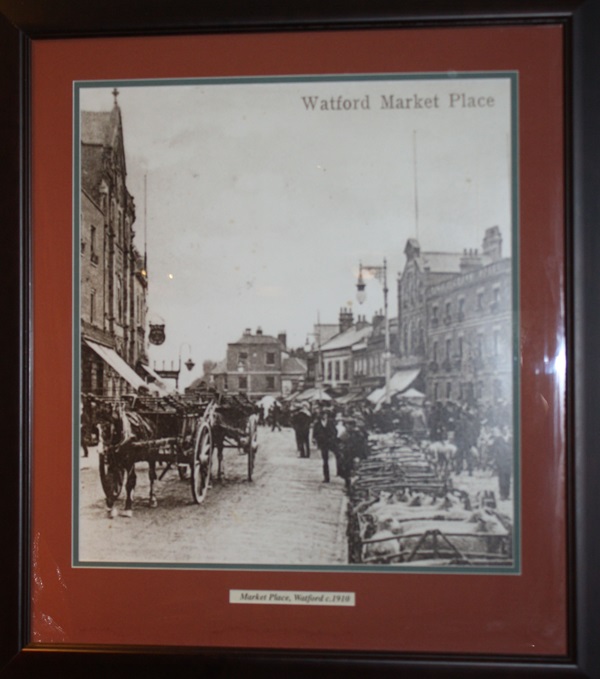
Photographs of Market Place, Watford, c1910.
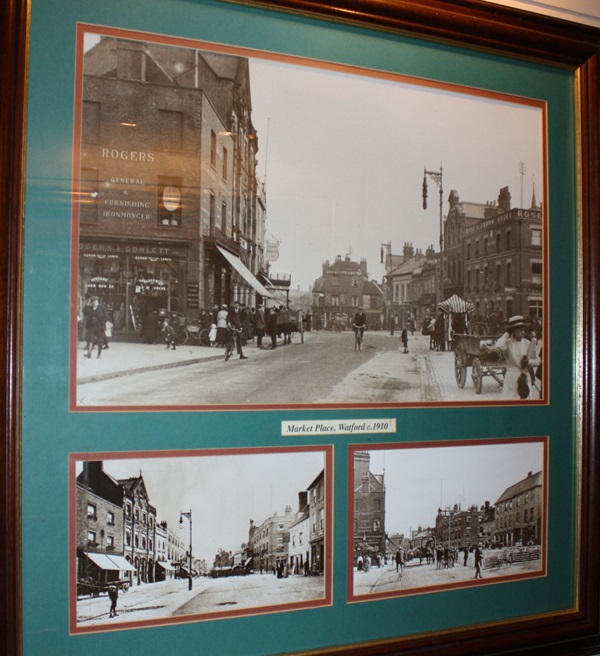
Prints of the flood, Watford High Street, June 1903.
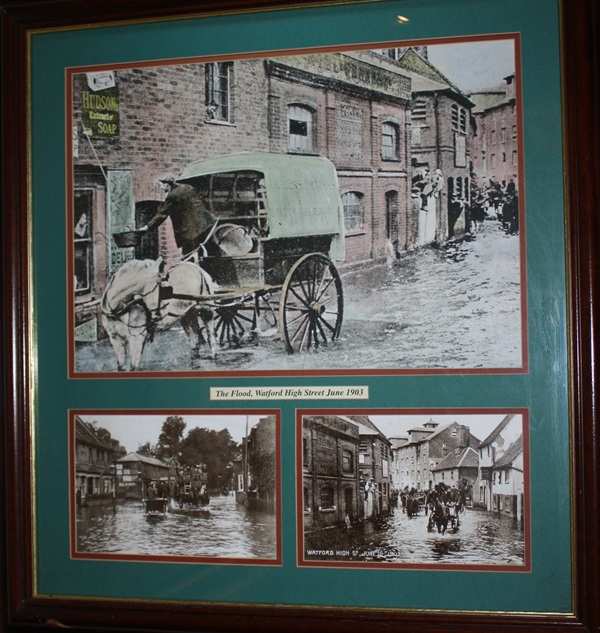
External photograph of the building – main entrance.
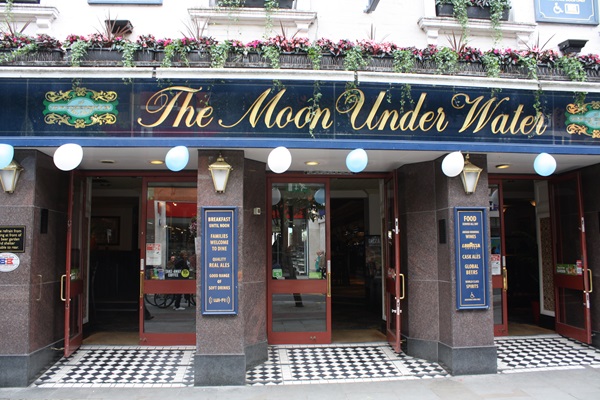
If you have information on the history of this pub, then we’d like you to share it with us. Please e-mail all information to: pubhistories@jdwetherspoon.co.uk